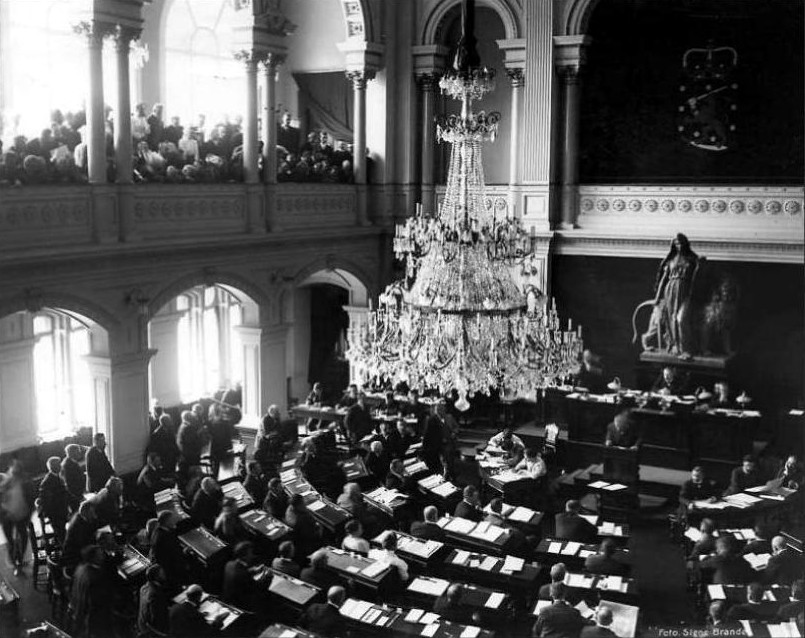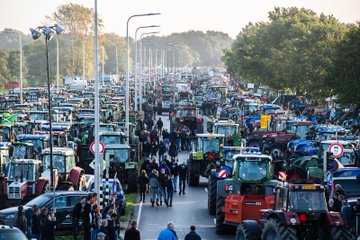Considering that groups like Extinction Rebellion and The Climate Mobilization want all activity in society to be centered around combating a rise of CO2 levels, and strive to put citizens and society into a state of emergency mobilization similar to WWII, as argued in this post, one may wonder, if there might be a relationship between the more modern green movements with the green movements and policies of the National Socialist German Workers' Party (NSDAP) in Germany during the early part of the 20th century? Although I could ask the question, I was not able to come up with a clear answer, but I did dig around the issue and found excepts and sources that might add perspectives to what is seen at present.
The relation between man and nature has been a subject in many traditions, dating back to a time when knowledge was transmitted also in stories. In Noway for instance a fairy tale collected around the middle of the 19th century, The daughter of the husband and the daughter of the wife is easily interpreted to include the moral, that if one listens to and is good to Nature, including the twigs of the trees, the cows, the sheep and listens to the songs of the birds then Nature is kind and will help you in return. More explicit examples of stories are some of the fairy tales of Hans Christian Andersen, that dealt with the pollution of the environment as a result of industrialization. According to How 19th century fairy tales expressed anxieties about ecological devastation
The issue of the relationship between the ecological movement and the National Socialist German Workers' Party has been a topic in How Nazi Are the Greens? National Socialism and the German Green Party from 2014, written by Kyle Bridge. It is a course essay by a graduate student, and reviews the conclusions of some of the books on the subject:
Continuing with the essay by Bridge there is:
In an article by Kaitlin Smith written for teachers and homeschoolers, one finds a reference to “Fascist Ecology: The ‘Green Wing’ of the Nazi Party and its Historical Antecedents,'" by Peter Staudenmaier which is a chapter of a book, Ecofascism Revisited Lessons From the German Experience and according to this page the first edition was published in 1995. In 2001 Staudenmaier also published a shorter paper with the same title: Fascist Ecology: The "Green Wing" of the Nazi Party and its Historical Antecedents which contains some excerpts that might indicate why the ideas of ecology were popular in Germany at the time.
Earlier I quoted the essay by Bridge who wrote: "The field has moved beyond Bramwell's continuity and historical parallels. Nuance characterizes new approaches to ecologism in Nazi Germany." Maybe the research has move beyond, but the books by Anna Bramwell were some of the very first on this issue and resulted in much later research on the topic. Two of the books were:
Blood and soil: Richard Walther Darré and Hitler's "Green Party" from 1984
Ecology in the 20th Century: A History from 1989
To give an idea of the content, there is Review of Bramwell's Hidden History of Environmentalism. by William Water Kay, author of The Green Swastika who posted the following on his webpage ecofascism.com
The relation between man and nature has been a subject in many traditions, dating back to a time when knowledge was transmitted also in stories. In Noway for instance a fairy tale collected around the middle of the 19th century, The daughter of the husband and the daughter of the wife is easily interpreted to include the moral, that if one listens to and is good to Nature, including the twigs of the trees, the cows, the sheep and listens to the songs of the birds then Nature is kind and will help you in return. More explicit examples of stories are some of the fairy tales of Hans Christian Andersen, that dealt with the pollution of the environment as a result of industrialization. According to How 19th century fairy tales expressed anxieties about ecological devastation
As urban life became increasingly distanced from nature, Andersen’s fairy tales thrived. While Victorian fantasy literature often romanticised nature as an escape from the encroaching industrial landscape, Andersen showed human characters as the source of environmental degradation.
For example, Andersen’s stories The Fir Tree, The Daisy and The Flax, feature plants that are tortured and abused by human characters. In these stories, talking plants suffer the dangers of industry.
Despite the pain they experience, these plants are selfless providers willing to compromise their personal happiness for human interest. These sympathetic depictions of nature, during a century of environmental devastation, encouraged children to reflect on their impact on the landscape.
Other tales, such as The Great Sea Serpent, detail the emerging conflict between animals and technology. The story describes fish reacting to the installation of the transatlantic telegraph cable, which ran the length of the Atlantic ocean between Europe and America.
With the chaos of the installation, schools of fish become separated, sea-anemones “were so agitated that they threw up their stomachs” and the cod and flounders who once “lived peacefully” began to eat their neighbours.
When the fish rally together to destroy the cable, a shark is impaled by a sword-fish and “great fishes and small, sea-anemones and snails rushed at one another, ate each other, mashed and squeezed in” while “the cable lay quietly and attended to its affairs”. The telegraph cable is not a positive technological breakthrough, but a threat to the environment.
The issue of the relationship between the ecological movement and the National Socialist German Workers' Party has been a topic in How Nazi Are the Greens? National Socialism and the German Green Party from 2014, written by Kyle Bridge. It is a course essay by a graduate student, and reviews the conclusions of some of the books on the subject:
The source given is: Uekoetter, "Green Nazis? Reassessing the Environmental History of Nazi Germany," German Studies Review 30, no. 2 (May 2007), 267 The abstract reads:"Uekoetter, no doubt in response to the relative flood of work and renewed interest in the topic, soon offered a complete historiography of conservation in Nazi Germany. He found no singular, consistent elements but generalized that early work argued for a link between German conservationism and "racist, antisemitic, and antidemocratic idea." More recent scholarship, he observed, "raised significant doubts about such a narrative and essentially disproved its validity."
When one reads the above, one wonders if some ecological minded people and organisation even today, are continuing a pattern of being opportunistic? This subject was mentioned from the perspective of companies in this article from 2007: Is Big Business Buying Out the Environmental Movement? Corporate Research E-Letter No. 65, May-June 2007The ideological lines between the conservation movement and the Nazi regime have received much attention. This article explores a new perspective by focusing on the level of practical politics. After several setbacks and disappointments since 1933, the passage of the national conservation law in 1935 became the crucial turning point. The law instilled a secular boom of conservation work, which lasted until about 1940, nourishing an atmosphere of almost unlimited enthusiasm for the Nazi regime in conservation circles. At the same time, conservationists were crossing sensitive thresholds in their desire to use the law to the greatest extent possible.
They next list three areas: Defeat, Diversion and Opportunism. One may of course ask what the situation is today, 12-13 years later, diversion and opportunism is probably high, while the defeated may increasingly become the average taxpayer and consumer that has to pay for the green technology to combat CO2 while in many cases this CO2 reduction, when all is counted and included is much less than advertised.This may turn out to be the year that big business bought a substantial part of the environmental movement.
That’s one way of interpreting the remarkable level of cooperation that is emerging between some prominent environmental groups and some of the world’s largest corporations. What was once an arena of fierce antagonism has become a veritable love fest as companies profess to be going green and get lavishly honored for doing so. Earlier this year, for instance, the World Resources Institute gave one of its “Courage to Lead” awards to the chief executive of General Electric. [...]
Everywhere one looks, enviros and executives have locked arms and are marching together to save the planet. Is this a cause for celebration or dismay?
Answering this question begins with the recognition that companies do not all enter the environmental fold in the same way. Here are some of their different paths:
Continuing with the essay by Bridge there is:
The article by Staudenmaier being referred to is: Organic Farming in Nazi Germany: The Politics of Biodynamic Agriculture, 1933–1945 and the abstract of that article has:"In an April 2013 article on Nazi biodynamic agriculture, Peter Staudenmaier also found a "more complex history," indicating "ambiguous interactions between biodynamic proponents and competing groups of Nazi officials." The field has moved beyond Bramwell's continuity and historical parallels. Nuance characterizes new approaches to ecologism in Nazi Germany."
The words "entwinement ... was more extensive" present a different picture than when Bridge merely quotes "ambiguous interactions" which admittedly fits better with how the essay ends.The controversy over the nature and extent of official support for organic agriculture in Nazi Germany has generally focused on the minister of agriculture, R. W. Darré, and his putative endorsement of biodynamic farming. By shifting focus from the figure of Darré to other sectors of the Nazi hierarchy, this article reexamines a contested chapter in the environmental history of the Third Reich. Using previously neglected sources, I trace several important bases of institutional support for biodynamic agriculture spanning much of the Nazi period. Both the biodynamic movement and the Nazi Party were internally heterogeneous, with different factions pursuing different goals. While some Nazi agencies backed biodynamic methods, others attacked such methods for ideological as well as practical reasons, particularly objecting to their occult origins. The article centers on the political dimension of these disputes, highlighting the relative success of the biodynamic movement in fostering ongoing cooperation with various Nazi organizations. I argue that the entwinement of biodynamic advocates and Nazi institutions was more extensive than scholars have previously acknowledged. "
In an article by Kaitlin Smith written for teachers and homeschoolers, one finds a reference to “Fascist Ecology: The ‘Green Wing’ of the Nazi Party and its Historical Antecedents,'" by Peter Staudenmaier which is a chapter of a book, Ecofascism Revisited Lessons From the German Experience and according to this page the first edition was published in 1995. In 2001 Staudenmaier also published a shorter paper with the same title: Fascist Ecology: The "Green Wing" of the Nazi Party and its Historical Antecedents which contains some excerpts that might indicate why the ideas of ecology were popular in Germany at the time.
Staudenmaier has also written a number of comments and articles on the founder of Anthroposophy and biodynamic farming including a book Between Occultism and Nazism: Anthroposophy and the Politics of Race in the Fascist Era. Apparently after the WWII the anthroposophist were reluctant to acknowledge their interactions and contributions to the NSDAP and this is one subject that Staudenmaier is interested in revealing, but not because he is against pure grown food. In this essay from 2011 Right-wing Ecology in Germany: Assessing the Historical Legacy Epilogue to Janet Biehl and Peter Staudenmaier, Ecofascism Revisited the author explains his own position:Germany is not only the birthplace of the science of ecology and the site of Green politics' rise to prominence; it has also been home to a peculiar synthesis of naturalism and nationalism forged under the influence of the Romantic tradition's anti-Enlightenment irrationalism. Two nineteenth century figures exemplify this ominous conjunction: Ernst Moritz Arndt and Wilhelm Heinrich Riehl. While best known in Germany for his fanatical nationalism, Arndt was also dedicated to the cause of the peasantry, which lead him to a concern for the welfare of the land itself. Historians of German environmentalism mention him as the earliest example of 'ecological' thinking in the modern sense. 4 His remarkable 1815 article On the Care and Conservation of Forests, written at the dawn of industrialization in Central Europe, rails against shortsighted exploitation of woodlands and soil, condemning deforestation and its economic causes. At times he wrote in terms strikingly similar to those of contemporary biocentrism: "When one sees nature in a necessary connectedness and interrelationship, then all things are equally important -- shrub, worm, plant, human, stone, nothing first or last, but all one single unity." 5
[...]
Riehl, a student of Arndt, further developed this sinister tradition. In some respects his 'green' streak went significantly deeper than Arndt's; presaging certain tendencies in recent environmental activism, his 1853 essay Field and Forest ended with a call to fight for "the rights of wilderness." [...] Riehl was an implacable opponent of the rise of industrialism and urbanization; his overtly antisemitic glorification of rural peasant values and undifferentiated condemnation of modernity established him as the "founder of agrarian romanticism and anti-urbanism." 7
[...]
In 1867 the German zoologist Ernst Haeckel coined the term 'ecology' and began to establish it as a scientific discipline dedicated to studying the interactions between organism and environment. Haeckel was also the chief popularizer of Darwin and evolutionary theory for the German-speaking world, and developed a peculiar sort of social darwinist philosophy he called 'monism.' [...] The pioneer of scientific ecology, along with his disciples Willibald Hentschel, Wilhelm Bölsche and Bruno Wille, profoundly shaped the thinking of subsequent generations of environmentalists by embedding concern for the natural world in a tightly woven web of regressive social themes.
On Amazon where the updated version of their book is sold, there is about the author:I want a vibrant and politically conscious organic farming movement, and that means coming to terms with the less pleasant aspects of the movement’s past
The above essay is a few years old, but any danger of a totalitarian regime coming from the liberals or from the left was not visible at the time, at least he ends:He has also been an active participant in the anarchist movement, the green movement, and the cooperative movement in the United States and Germany for over two decades.
One wonders how he sees the present developments, but it is great he has had the tenacity to stay with the subject, has updated and commented on his earlier work on several occasions.I remain a social ecologist fully committed to a thoroughgoing transformation of society and of human relations with the natural world. If ecological thinkers and activists do not foster lasting links to a broader left political practice and a comprehensive outlook based on radical social critique, we risk losing the creative potential, subversive possibilities, and challenging prospects of an approach which takes natural and social change equally seriously.
Earlier I quoted the essay by Bridge who wrote: "The field has moved beyond Bramwell's continuity and historical parallels. Nuance characterizes new approaches to ecologism in Nazi Germany." Maybe the research has move beyond, but the books by Anna Bramwell were some of the very first on this issue and resulted in much later research on the topic. Two of the books were:
Blood and soil: Richard Walther Darré and Hitler's "Green Party" from 1984
Ecology in the 20th Century: A History from 1989
To give an idea of the content, there is Review of Bramwell's Hidden History of Environmentalism. by William Water Kay, author of The Green Swastika who posted the following on his webpage ecofascism.com
One reason why advocates of green policies may easily become associated with power is, because in order for policies and regulations to become implemented power and support is needed. If the analysis of Bramwell really brings out some of the corruption of the scientific community, as it was in the 1970'ies and 1980ïes, then little has changed.What follows is a critical and supplemented condensation of three books on the history of environmentalism written between 1985 and 1994 by Oxford History Professor Anna Bramwell. The latter two books were published by Yale University. The books make clear the Third Reich was a radical environmentalist regime. The Nazis promoted organic farming, reforestation, species preservation, naturalism, neo-paganism, holistic science, animal rights, sun-worship, herbalism, anti-capitalism, ecology, anti-urbanism, alternative energy, hysterical anti-pollutionism and apocalyptic anti-industrialism. At the same time the British ecology movement was stridently, treasonously fascist. While these aspects of Bramwell’s writings have been commented on, however inadequately, much less has been said about her treatment of post-WWII environmentalism. Here she provides useful insights into the wholesale corruption of the scientific community, the capturing of key organizations and the manipulation of the mass media by the environmental movement. Bramwell is not a passive observer of this process and conceals key players, interests and motives.











 Thanks, Pashalis, that was good! Shared.
Thanks, Pashalis, that was good! Shared. The hubris!
The hubris!